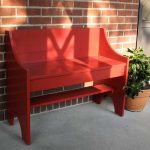We may receive a commission when you use our affiliate links. However, this does not impact our recommendations.
 I’ve been thinking about Col. Steve Austin a lot lately. You might remember him as the Six Million Dollar Man, a character from the TV series in the ’70s with the same name. After being seriously injured in a test flight, Austin is given artificial replacements for his legs, his right arm, and one eye. These gave him superhuman speed, strength, and telescopic vision. In the beginning of the show, a voice says, “We can make the first bionic man. Better than he was before. Better. Stronger. Faster.”
I’ve been thinking about Col. Steve Austin a lot lately. You might remember him as the Six Million Dollar Man, a character from the TV series in the ’70s with the same name. After being seriously injured in a test flight, Austin is given artificial replacements for his legs, his right arm, and one eye. These gave him superhuman speed, strength, and telescopic vision. In the beginning of the show, a voice says, “We can make the first bionic man. Better than he was before. Better. Stronger. Faster.”
Not such a bad deal, when you think about it.
He’s been on my mind because of a few nagging injuries I’ve had in the last few weeks. They have been hanging around like a penniless kid in a candy store.
In high school I was a distance runner, but the long miles on the roads really did a job on my knee joints. I only run occasionally now – if I’m at the beach or on grass, where the impact is less jarring. Instead, I ride just under a 100 miles a week on my bicycle. I get the bulk of the miles done on the weekend in the morning. During the week, I have a 15-mile loop that I try to get in a couple of times. It includes a nice stretch on a four-lane highway, and some really serious hills on the way back home.
The problem with cycling is you get a whole different type of injury. If your seat is not at the proper height, you could mess up your knees, the vibration from the road adds up on your wrists, and you always have the possibility of crashing or getting hit by a distracted motorist. Or, as in some areas where I lived, motorists who think it’s great fun to knock you off the road.
So I’ve been having these spasms in my left knee throughout the day for weeks now, a wrist that is constantly sore (don’t know how I injured it), and my eyesight isn’t getting better like it did for my grandfather.
This became painfully clear as I was trying out Bosch’s new random-orbit sander the other day that is designed to reduce vibration. Steve Shanesy is writing about the tool in our next issue. While it clearly does a better job than other sanders I own, my wrist was killing me after only a short while. And the same thing happened this morning when I broke out my die grinder. Granted, I had a huge carbide bit chucked in it for a carving into pine, but the vibration from the tool soon left my wrist numb.
I remember a carpenter I worked with years ago. He was in his 60s and he taught me a lot of tricks on the job. Of course, when he started the trade, the air nailer hadn’t been invented yet, so because he swung a hammer for so many years, he could no longer close his hand completely. Rather, the closest he could come was to the shape of a hammer handle in his hand.
How are you dealing with injuries in the shop? Any recommendations for our readers?
Here are some supplies and tools we find essential in our everyday work around the shop. We may receive a commission from sales referred by our links; however, we have carefully selected these products for their usefulness and quality.










I’ll second Robert’s weight lifting suggestion.
You can’t do aerobic workouts (biking, running, swimming etc.) without lifting some type of weights. You see that more and more aerobics classes use a ‘body pump’ type workout that involves weights once they’ve gotten classes up and running with basic aerobic fitness.
I do an aerobic weight routine that I had designed by a professional trainer (paid for of course). My progress is monitored by the trainer.
Not only does the routine help in the shop, but it’s helped reduce or eliminate the effects some injuries (that were known to the trainer).
I use handplanes regularly and the weight workout makes a huge difference for that work. Handplanes are a good workout, but again, alone, they don’t allow for a complete muscle workout.
Everyone should have some type of at least, aerobic weight workout. If you want to powerlift, it’s aerobic too if the workout is properly designed. But as I get older, all I want to be able to do is push a handplane and be able to put a soup can in the cupboard.
You might want to consider a recombant bike. Spinal positioning of a bike rider is the horizontal equivalent of a hockey goalie (hopefully without the concussions). Trust me, I know. Pitfalls of regular road bikes include:
1) Aggravation of lumbar/lower back degeneration, especially L4/L5.
2) Intensification of carpal tunnel problems. In turns out that many carpal tunnel ailments are not only wrist problems but degeneration of the cervical/neck spine (C3-C7). Shouldn’t be a problem if all you do is look down at your front wheel, though.
3) Tall riders try doing things we short riders wouldn’t consider. Like reaching back to the rear tire to clear debris from it. Not a good idea. Don’t believe me? Just ask my physician, who has just about recuperated from his broken hip.
oops – I just realized I thought I was replying to Megan’s blog! Sorry – well Alex – all my thoughts apply to guys as well! Sorry for my mix up.
Hi Megan,
I feel your pain. I am a healthy 52 year old female that is active and just began carpentry in the last five years and woodworking in the past two years. I have the tweaks in all the usual suspect places. My neck from drilling, my knees from practically anything for more than two hours and my back from doing stupid things.
I am also a bike rider. I have found bike riding is the best way to stay in shape without hurting yourself. If you are fit properly on your bike, it pays off big time in comfort. I would avoid the drop down bars as this is counter to your natural neck position, and braking will most definitely stress the wrists without top levers.
The other thing that has been a huge help is Yoga. Even if you don’t have time or patience for a class, get a dvd and stretch for about 20 minutes a day. It really is remarkable how you feel. If you have time for weight resistance -women need it plain and simple.
I think the tweaks are going to be unavoidable, but conditioning your body before you hurt yourself is the best we can try for.
Good luck! I love that there is a female voice in your publication, and I really enjoy learning the hand tools.
Just a quick note: I was slow in finding time to edit (sorry) – so after my changes, I removed the now no-longer-applicable comments.
Cheers,
megan
A caution – if your wrist hurts, and (most importantly!) if it’s numb after a short session with a sander, you’re in serious trouble.
“Serious” as in “Do no further woodworking, bike riding or anything else that will put strain on your wrist for 6 weeks”. Failing to do this may cost you several months of out-of-action time after carpal tunnel surgery.
And before you go back to it, get your orthopedist to sign off. Repetive motion injuries are no joke.
And if you do get back to the bike, ride a “crossover” (a hybrid mountain/road bike). These can be equipped with front and rear shocks, which will dramatically reduce the road vibration.
Ajax:
I was an endurance athlete and started to get stupid nagging injuries/pains – just figured I was getting older. Decided to try lifting weights. I started slow using ridiculously low weights and 3 sets of 10 reps, for one hour twice per week for the first 6 months. You can’t just jump right into lifting. After the first 6 months I increased the amount I was lifting. Now I still lift for an hour twice per week but do one light day (low weights / high reps) one heavy day (high weights / low reps) per week.
I cut out the really strenuous running (kept feeling beat up after a run) and replaced it with a vigorous 3-mile walk.
Now five years latter, I feel better and stronger than when in my 20s. That said, everyone has to figure out what works for themselves. Good luck.
Hey Ajax,
You raise an important point that I think about all the time. I think being a craftsperson has lots of parallels to being a professional athlete: both group rely on their physical condition (and conditioning) to earn a living.
I became intensely aware of this back in college when I became fairly serious about both rock-climbing and glassblowing. I would go climbing at least 3 or 4 times a week and blow glass for upwards of 12 hours at a time (also I was starting to work on very large and heavy pieces). Within a year or so, I started having shooting pains in my wrists and hands- a fairly fairly discouraging for someone in their early 20’s. I made the decision that being able to use my hands for the rest of my life to make things trumped the enjoyment of rock climing and I gave it up. After months wearing wrist restraints working on small thin cups and goblets, my wrist pains subsided and haven’t come back. However the thought of injury or incapacitation is always on my mind. I approach repetitive stress injuries the same way I view personal safety, particulate control, etc.. anything (in or out of the shop)that can potentially stand in the way of me working to a ripe old age is not worth taking the risk on.
Cheers,
Niels
Ditch the sander, get a scraper instead and a sanding block. For the bike, ditch the straight handlebars and get old fashioned racing (curled down) handlebars. There won’t be as much stress on the wrists as you can pick what position is best for you. Of course, your neck may hurt a bit but that’s just aging.
Gary